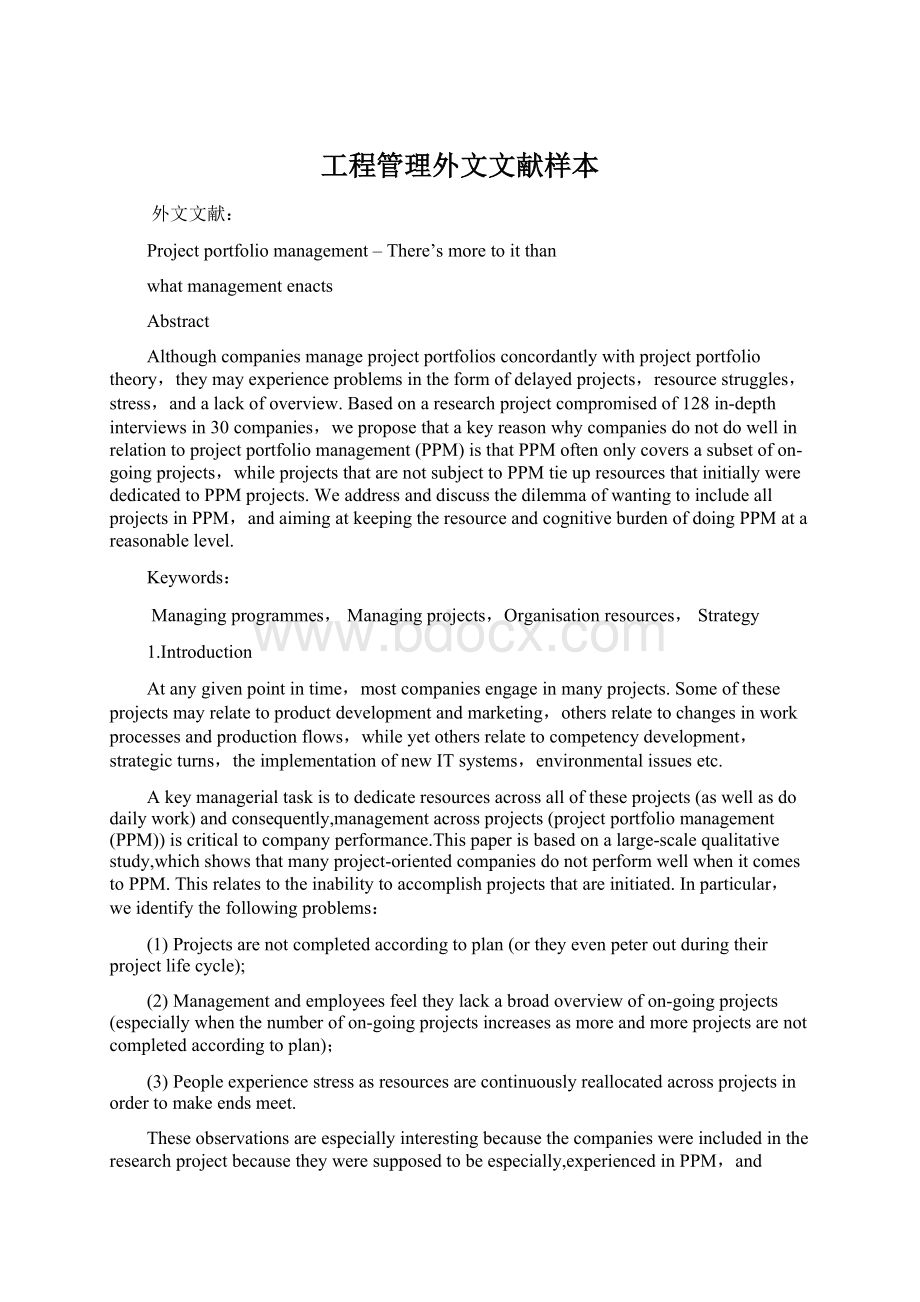 工程管理外文文献样本文档格式.docx
工程管理外文文献样本文档格式.docx
- 文档编号:16691608
- 上传时间:2022-11-25
- 格式:DOCX
- 页数:9
- 大小:23.74KB
工程管理外文文献样本文档格式.docx
《工程管理外文文献样本文档格式.docx》由会员分享,可在线阅读,更多相关《工程管理外文文献样本文档格式.docx(9页珍藏版)》请在冰豆网上搜索。

whatmanagementenacts
Abstract
Althoughcompaniesmanageprojectportfoliosconcordantlywithprojectportfoliotheory,theymayexperienceproblemsintheformofdelayedprojects,resourcestruggles,stress,andalackofoverview.Basedonaresearchprojectcompromisedof128in-depthinterviewsin30companies,weproposethatakeyreasonwhycompaniesdonotdowellinrelationtoprojectportfoliomanagement(PPM)isthatPPMoftenonlycoversasubsetofon-goingprojects,whileprojectsthatarenotsubjecttoPPMtieupresourcesthatinitiallywerededicatedtoPPMprojects.WeaddressanddiscussthedilemmaofwantingtoincludeallprojectsinPPM,andaimingatkeepingtheresourceandcognitiveburdenofdoingPPMatareasonablelevel.
Keywords:
Managingprogrammes,Managingprojects,Organisationresources,Strategy
1.Introduction
Atanygivenpointintime,mostcompaniesengageinmanyprojects.Someoftheseprojectsmayrelatetoproductdevelopmentandmarketing,othersrelatetochangesinworkprocessesandproductionflows,whileyetothersrelatetocompetencydevelopment,strategicturns,theimplementationofnewITsystems,environmentalissuesetc.
Akeymanagerialtaskistodedicateresourcesacrossalloftheseprojects(aswellasdodailywork)andconsequently,managementacrossprojects(projectportfoliomanagement(PPM))iscriticaltocompanyperformance.Thispaperisbasedonalarge-scalequalitativestudy,whichshowsthatmanyproject-orientedcompaniesdonotperformwellwhenitcomestoPPM.Thisrelatestotheinabilitytoaccomplishprojectsthatareinitiated.Inparticular,weidentifythefollowingproblems:
(1)Projectsarenotcompletedaccordingtoplan(ortheyevenpeteroutduringtheirprojectlifecycle);
(2)Managementandemployeesfeeltheylackabroadoverviewofon-goingprojects(especiallywhenthenumberofon-goingprojectsincreasesasmoreandmoreprojectsarenotcompletedaccordingtoplan);
(3)Peopleexperiencestressasresourcesarecontinuouslyreallocatedacrossprojectsinordertomakeendsmeet.
Theseobservationsareespeciallyinterestingbecausethecompanieswereincludedintheresearchprojectbecausetheyweresupposedtobeespecially,experiencedinPPM,andbecausetheyactuallyengageinPPMaccordingtotheextantbodyofliteratureonPPM.Forexample,partofthecompanies’PPMincludedanefforttopickthebestprojectsonthebasisofexplicitorimplicitcriteria,andanefforttoallocatesufficientresourcestotheseprojects.
However,despiteefforts,topractice‘good’PPM,thesecompaniesexperiencesevereproblemsinrelationtoPPM–especiallyinlettingenoughresourcesgointothe‘right’projects.ThepurposeofthispaperistoconfrontPPMasadvocatedbynormativetheorieswithactualPPMpractices.Hence,thepurposeistoconfrontPPMtheorieswithPPMasperceivedbymanagersandotheremployeesforwhomPPMispartof,oraffects,theirworkconditions.
However,inthispaper,wearemoreinterestedinPPMasenactedbycompaniesthaninuniversallytrueperceptions.Hence,weadheretoWeick’s[1–3]notionofenactmentasthepreconceptionsthatareusedtosetasideaportionofthefieldofexperienceforfurtherattention.InregardtoPPM,enactedprojectsarethustheonesmanagementsetsasideforfurtherattention(i.e.PPM).Assuch,wefocusespeciallyonwaysactorsdefineorenactprojects[4]andmakesenseofhowtomanagethesumoftheprojects.Drawingonthisperspective,weaccountforfindingsthatsuggestwhycompaniesthatdoengageinPPMstillexperienceproblems.
2.Projectportfoliotheory
ThispaperdrawsonArcherandGhasemzadeh’s[5,p.208]definitionofprojectportfoliosas‘‘agroupofprojectsthatarecarriedoutunderthesponsorshipand/ormanagementofaparticularorganization’’.Henceforth,wedefinePPMasthemanagerialactivitiesthatrelateto
(1)theinitialscreening,selectionandprioritisationofprojectproposals,
(2)theconcurrentreprioritisationofprojectsintheportfolio,
(3)theallocationandreallocationofresourcestoprojectsaccordingtopriority.
Forquitesometimeresearchershavesuggestedthatlowcompletionratesfornewproductdevelopment(NPD)projectsandnewproductfailurerelatetoresourcedeficienciesinkeyareas[6,7].Furthermore,whileahostofresearchers[8–10]havefocusedonthedimensionofPPMthatconcernsprocessesrelatingtoselectionofprojectstobeincludedintheportfolio,researche.g.[11]alsoincreasinglyfocusesontheday-todaymanagementoftheprojectportfolio.
3.Methodology
Overaperiodoftwoyears,wedidempiricalresearchonhowcompaniesmanagetheirentirerangeofprojects,e.g.renewalprojects,strategicprojects,ITprojects,departmentallyspecificprojects,andproductionbasedprojects.Inrelationtotheselectionofcompaniestobeincludedintheempiricalstudy,akeycriterionwasthatthestudyshouldcoverawidevarietyofindustries.Asaresult,theempiricalstudycovers30companiesfromindustriesasdiverseas,e.g.mobiletelephonecommunications,finances,energy,pharmaceuticals,toys,software,andfoods.
However,duetothefactthatwewerelookingforcompanies,wheretheamountofon-goingprojectssuggestedtheywereengagedinPPM,thestudyisbiasedtowardslargercompaniesaswellascompaniesthatdefineatleastasubstantialpartoftheiractivitiesasprojects.Thedegreetowhichthecompaniesparticipatedinthestudyvaries.Hence,halfofthecompaniesarelabelled‘innercircle’companiesduetothefactthatwedrewextensivelyonthese15companies.Forexample,inthesecompaniesmoreinterviewswereconductedatvariouspointsintimeandatvariousorganizationallevels.Hence,alongitudinalperspectivecharacterizestheinvolvementofthesecompanies.
Theremaininghalfofthecompaniesarelabelled‘outercircle’companiesbecausetheirparticipationinthestudyhasincludedfewertop-managementinterviews,thepurposeofwhichwastogaininsightintowaysinwhich(top)managementdefinesthecontentoftheirprojectportfoliosandmanagesthem.
4.Managerialimplications
Akeyfindingisthatthegapbetweenrequiredandavailableresourcesisverymuchattributabletotheexistenceofahostofsmallerprojectsthatneverbecomepartofenactedprojectportfolios.Thus,atanaggregatedlevel,theempiricalstudysuggestssmaller,un-enactedprojectsqualifyasresourcescrunchersinsofartheyarenotconsideredtobeapartofenactedprojectportfolios.Inordertoovercomethiscrunchinresources,twosolutionsseemobvious:
(1)Enactingmore,i.e.havingPPMembraceallprojects.
(2)Allocatingmoreresourcestoapoolofloosely-controlledresourcesfortheun-enactedprojectstodrawon.
5.Researchimplications
Theempiricalstudyelaboratesonthe‘‘significantshortageofresourcesdevotedtoNPD’’thatCooperandEdgettargueisthefundamentalproblem‘‘thatplaguesmostfirms’productdevelopmentefforts’’.
Ourworkespeciallysuggeststhattheshortageofresourcesdevotedtoenactedprojectsisnotaproblemthatprimarilyarisesinrelationtotopmanagement’sPPM.Onthecontrary,in-good-faithtopmanagementdedicatesresourcestoenactedprojectsonthebasisofsoundPPM.However,whattopmanagersdonotdoistakeintoaccountthehostofsmallerprojectsthatindividualsinitiateand–moreimportantly–topmanagersignore(oratleastheavilyunder-estimate)theamountofresourcesthatthesesmallerprojectstieup.Hence,wearguethatespeciallythecrunchinresourcesmaybeattributabletotheun-enactedcompetitionforresourcesthatsmallerprojectssubjectenactedprojectsto.
Consequently,thekeycontributionofourempiricalworktoresearchisthatitemphasisesthatifwewishtostudyPPM(andespeciallyifwewishtorelatePPMtoprojectperformance),wemightbebetterofftakingintoaccounttheentirerangeofprojectsthatactual(notenacted)portfoliosarecomprisedof.Thus,ifweasresearchersonlyenacttheprojectsthatareneatlylistedbytopmanagement,thenourresearchwillneglectthehostofprojectsthatarenotsubjecttoPPM,projectsthatnonethelesstakeupvaluable,andscarce,resources.
Thefactthattheempiricalstudyincludesinterviewswithmanagers,i.e.thosewhodoPPM,andinterviewswithpersonnelatlowerorganisationallevels,i.e.thosewhoseworkissubjecttoPPM,isthereasonwhywewereabletoidentifyun-enactedprojects.Thus,researchersinterestedinPPMshouldbecarefulnottorelytooheavilyonamanagementperspective.
6.Conclusionandlimitations
Themainconclusionisthataslongassomeprojectsareun-enacted,companiesmayexperienceadrainonresourcesthatreducesthetimeandresourcesactuallydevotedtoprojectssubjecttoPPM.Hence,eachindividualcompanyshoulddecidewhetherornotallprojectsshouldbepartofPPMandiftheendresultofsuchadecisionisnottomakecomprehensiveprojectlists(i.e.liststhatincludeallminorprojects),thenmanagementshoulddecidehowmanyresourcesshouldbesetasidefortheplethoraofsmallprojectsthatdonotappearontheprojectlist.
Onewayinwhichthecrunchinresourcescanbereducedisbyensuringthatsmallerprojectsdonottakeupacriticalportionoftheresourcesthatare–officially–setasideforthecompletionofprojectssubjecttoPPM.However,duetotheexploratorynatureofthestudyaccountedforinthispaper,ourfindingsrelatefarmoretowhatcompaniesactuallydo(positivetheoryinHunt’sterms),ratherthantowhattheyoughttodo(normativetheoryinHunt’sterms).Althoughgeneratingpositivetheoryisindeedacrucialfirststep–especiallyinrelationtothefutureofPPMtheory
- 配套讲稿:
如PPT文件的首页显示word图标,表示该PPT已包含配套word讲稿。双击word图标可打开word文档。
- 特殊限制:
部分文档作品中含有的国旗、国徽等图片,仅作为作品整体效果示例展示,禁止商用。设计者仅对作品中独创性部分享有著作权。
- 关 键 词:
- 工程 管理 外文 文献 样本
 冰豆网所有资源均是用户自行上传分享,仅供网友学习交流,未经上传用户书面授权,请勿作他用。
冰豆网所有资源均是用户自行上传分享,仅供网友学习交流,未经上传用户书面授权,请勿作他用。


 如何打造酒店企业文化2刘田江doc.docx
如何打造酒店企业文化2刘田江doc.docx
